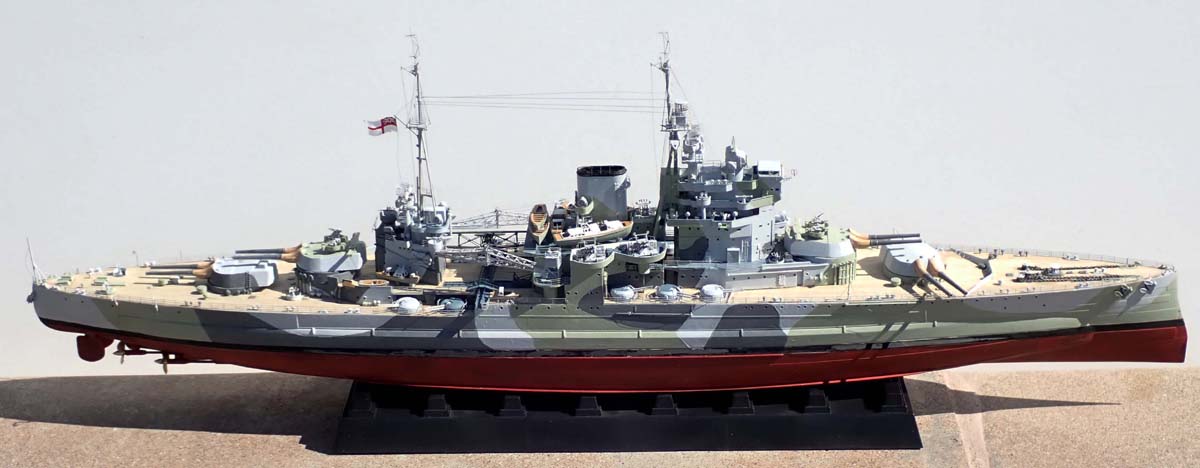
1/350 HMS Queen Elizabeth 1943 (Trumpeter)
|
by Robert Apfelzweig |

1/350 HMS Queen Elizabeth 1943 (Trumpeter)
Trumpeter’s HMS Queen Elizabeth portrays this storied warship in her summer (June – August) 1943 appearance, soon after completing major repairs and a refit in Norfolk, Virginia which she had undergone following being mined (along with her sistership HMS Valiant) by Italian frogmen while at anchor in Alexandria Harbor, Egypt in December 1941. After temporary repairs, the ship made the lengthy journey through the Suez Canal, stopping in Durban, South Africa for more repairs, then continuing around the horn of Africa and to the US east coast. She left Norfolk and headed back to Great Britain to rejoin the Home Fleet in July 1943, and at this point her appearance becomes a bit of a muddle for modelbuilders. I have portrayed her, based on photos (much helped by Norman Friedman’s book The British Battleship 1906-1946 and Les Brown’s monograph Queen Elizabeth Class Battleships), as she appeared during her journey home across the Atlantic. Soon after her incorporation back into the Home Fleet (after August 1943), she was repainted in a different disruptive camouflage scheme and her aircraft storage facilities converted into boat storage, the catapult being removed. Since I wanted to keep the catapult and Supermarine Walrus (I just used one of the two included) that came with the kit, and because Flyhawk Model’s extensive Super Detail set included a wood deck with cutouts for the catapult (more on that deck in a moment), I chose to show the ship during that short period of time. The choice of light grey-green for one of the three colors was somewhat uncertain, but I based it on a beautiful scratch-built 1:128 model of the QE (my apologies for the acronym) at this time in her career by Roger Antrobus, as illustrated in Les Brown’s book. As is often the case, Trumpeter’s paint scheme, while similar to period photos in terms of camouflage color shapes, is much too dark and uncertain (most colors are achieved, according to the illustration’s directions, by mixing various paints, some of which are apparently unavailable from any commercial source) to be useful.Trumpeter’s kit is quite sturdy, since the two-part (port and starboard) full hull sections are connected by over half a dozen perpendicular plastic braces. There is a small photoetch set, which I did not use, that mostly provides the four delicate Mk IV HA/LA fire control directors atop the forward and aft bridges. Flyhawk’s very extensive photoetch set includes a good amount of extra 2- and 3-bar railing, and not quite enough small mushroom vents (it turns out, according to Flyhawk’s illustrations, that many of the little pegs on the main and quarter decks of Trumpeter’s kit are meant to be these vents), and many more are shown in these instructions than are molded into the plastic decks. The wood deck is of a type that I don’t particularly like working with – very thin and fragile when narrow, with an even thinner cellophane sheet covering the adhesive underside that can be difficult to remove without tearing the wooden part. There was a good deal of blistering of the deck that required low viscosity CA glue to fix. The Flyhawk set also includes all brass gun barrels, including for the four octuple pom-poms, but I preferred to use entire MasterModel 20 mm Oerlikons because their barrels are fine cylinders, not the 2-dimensional ones in the Flyhawk set.
